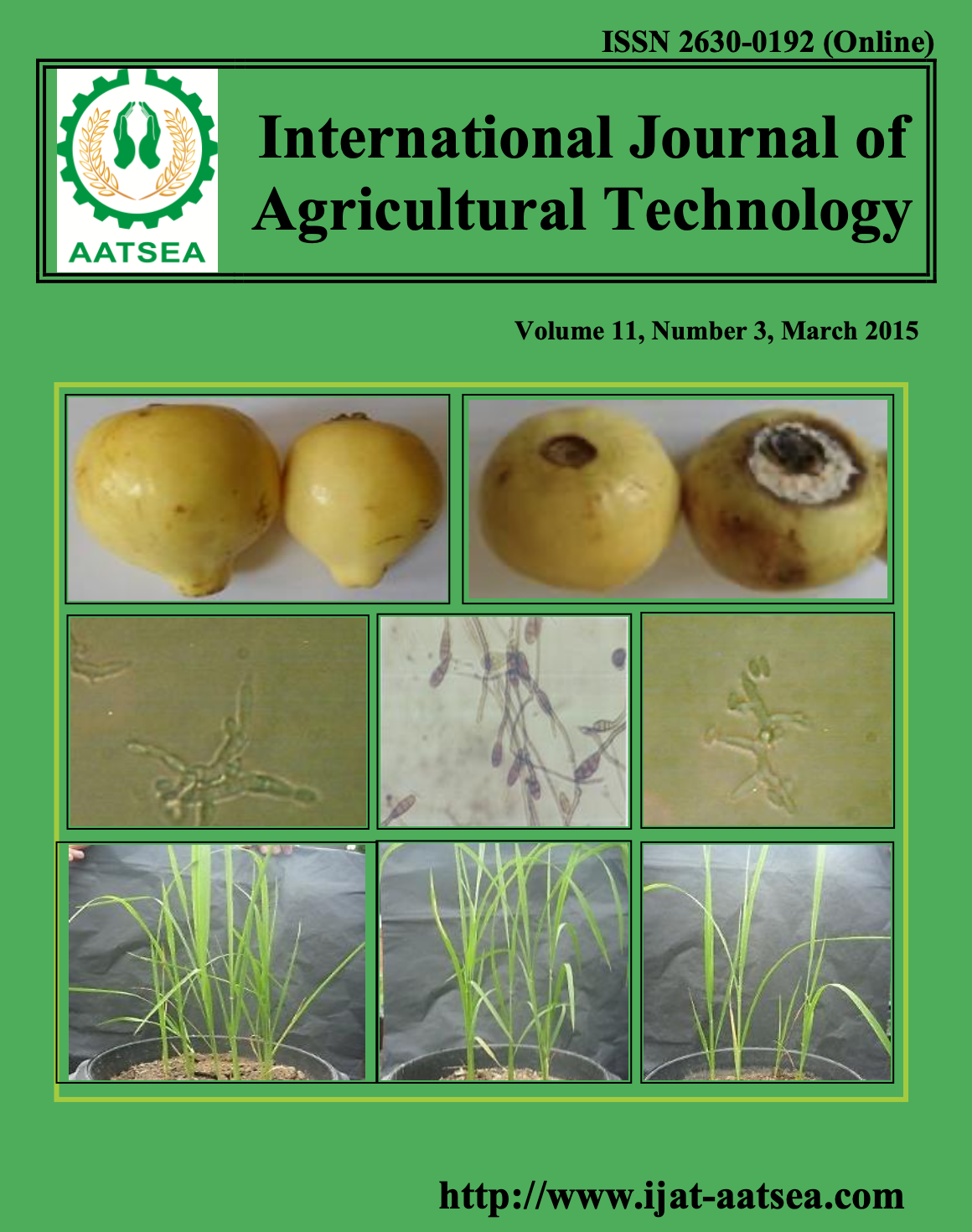Efficacy of essential oils from Citrus plants against mosquito vectors Aedes aegypti (Linn.) and Culex quinquefasciatus (Say)
Main Article Content
Abstract
Article Details

This work is licensed under a Creative Commons Attribution-NonCommercial-NoDerivatives 4.0 International License.
References
Abdel-Rahman, A., Shetty, A. K. and Abou-Donia, M. B. (2001). Subchronic dermal appli-cation of N, N-diethyl m-toluamide (DEET) and permethrin to adult rate, alone or in combination, causes diffuse neuronal cell death and cytoskeletal abnormalities in the cerebral cortex and hippocampus, and Purkinje neuron loss in the cerebellum. Experimental Neurology 172:153-171.
Amer, A. and Mehlhorn, H. (2006). Repellency effect of forty-one essential oils against Aedes, Anopheles and Culex mosquitoes. Parasitology Research 99:479-490.
Choochote, W., chaithong, U., Kamsuk, K., Jitpakdi, A., Tippawangkosol, P., Tuetun, B., Champakaew, D. and Pitasawat, B. (2007). Repellent activity of selected essential oils against Aedes aegypti. Fitoterapia 78:359-364.
Das, N. G., Baruah, I., Talukdar, P. K. and Das, S. C. (2003). Evaluation of Botanicals as repellents against mosquitoes. Journal of Vector Borne Diseases 40:49-53.
Du ponte, M. W. and Larish, L. B. (2009). Southern house mosquito. Retrieved from www.ctahr.hawaii.edv.
Gleiser, R. M., Bonio, M. A. and Zygadlo, J. A. (2011). Repellence of essential oils of aromatic plants growing in Argentina against Aedes aegypti (Diptera: Culicidae). Parasitology Research 108:69-78.
Isman, M. B. (2006). Botanical insecticides, deterrents and repellents in modern agriculture and an increasing regulated world. Annual Review of Entomology 51:45-66.
Isman, M. B., Wilson, J. A. and Bradbury, R. (2008). Insecticidal activities of commercial Rosemary oils (Rosmarinus officinalis) against larvae of Pseudaletia unipuncta and Trichoplusia ni in relation to their chemical composition. Pharmaceutical Biology 46:82-87.
Juckapa, S. (2009). Chikungunya. Retrieved from www.thaiherbs.com.
Kang, S. H., Kim, M. K., Seo, D. K., Noh, D. J., Yang, J. O., Yon, C. and Kim, G. H. (2009). Comparative repellency of essential oil against Culex pipiens pallens (Diptera: Culicidae). Journal of the Korean Society for Applied Biological Chemistry 52:353-359.
Karunamoorthi, K., Ramanujam, S. and Rathinasamy, R. (2008). Evaluation of lesf extracts of Vitex negundo L. (Family: Verbenaceae) against of Culex tritaeniorhynchus and repellent activity on adult vector mosquitoes. Parasitology Research 103:545-550.
Karunamoorthi, K., Ilango, K. and Murugan, K. (2010). Laboratory evaluation of traditionally used plant-based insect repellent against the malaria vector Anopheles arabiensis Patton (Diptera: Culicidae). Parasitology Research 106:1217-1223.
Koul, O., Walai, S. and Dhaliwal, G. S. (2008). Essential oils as green pesticides: potential and constraints. Biopesticides International 4:63.84.
Kumar, S., Wahab, N. and Wankoo, R. (2011). Bioefficacy of Mentha piperita essential oil against dengue fever mosquito Aedes aegypti L. Asian Pacific Journal of Tropical Biomedicine 1:90-93.
Misni, N., Sulaiman, S. and Othman, H. (2008). The repellent activity of Piper aduncum Linn. (Family: piperaceae) essential oil against Aedes aegypti using human volunteers Tropical Parasitology 31:63-69.
Ministry of Public health (2013). Dengue fever. Retrieved from http://webdb.dmsc.moph.go.th
Nerio, L. S., Olivero-Verbel, J. and Stashenko, E. (2009). Repellent activity of essential oils:A review. Bioresource Teehnology 101:372-378.
Nour, A. A., Elhussien, S. A., Osman, A. A. and Nour, A. H. (2009). Repellent activity of the essential oils of four Sudanese accessions of basil (Ocimum basilicum L.) against Anopheles mosquitoes. Journal of Applied Sciences 9:2645-2648.
Nitatpattana, N., Dubot-Peres, A., Gouilh, M. A., Souris, M., Barbazan, P. and Yoksan, S. (2008). Change in Japanese encephalitis virus distribution, Thailand. Emerging Infectious Diseases journal 14:1762-1765.
Phasomkusolsil, S. and Soonwera, M. (2010a). Insect repellent activity of medicinal plant oils against Aedes aegypti (Linn.) Anopheles minimus (Theobald) and Culex quinquefasciatus (Say) base on protection time and biting rate. The Southeast Asian Journal of Tropical Medicine and Public Health 41:831-840.
Phasomkusolsil, S. and Soonwera, M. (2010b). Potential larvicidal and pupacidal activity of herbal essential oils against Culex quinquefasciatus (Say) and Anopheles minimus (Theobald). The Southeast Asian Journal of Tropical Medicine and Public Health 41:1342-1351.
Phasomkusolsil, S. and Soonwera, M. (2011). Comparative mosquito repellency of essential oil against Aedes aegypti (Linn.) Anopheles minimus (Theobald) and Culex quinquefasciatus (Say). Asian Pacific Journal of Tropical Biomedicine 1:113-118.
Prajapati, V., Tripathi, A. K., Aggarwal, K. K. and Khanuja, S. P. S. (2005). Insecticidal, repel-lent and oviposition-deterrent activity of selected essential oils against Anopheles stephensi, Aedes aegypti and Culex quinquefasciatus. Bioresource Technology 96:1749-1757.
Pushpanathan, T., Jebanesan, A. and Govindarajan, M. (2008). The essential oil of Zingiber officinalis Linn. (Zingiberaceae) as a mosquito larvicidal and repellent agent against the filarial vector Culex quinquefasciatus Say (Diptera : Culicidae). Parasitology Research 102:1289-1291.
Rabha, B., Gopaiakrishnan, R., Baruah, I. and Sigh, L. (2012). Larvicidal activity of some essential oil hydrolates against dengue and filariasis vectors. Journal of Medical Research 1:14-16.
Ramaiah, K. D., Das, P. K., Michae, E. and Guyatt, H. (2006). The economic burden of Lymphatic filariasis in India. Parasitology Today 16:251-253.
Regnault-Roger, C., Vincent, C. and Arnason, J. T. (2012). Essential oils in insect control: low-risk products in a high-stakes world. Annual Review of Entomology 57:405-424.
Sakulku, U., Nuchuchua, O., Uawongyart, N., Puttipipatkhahorn, S., Soottitantawat, A. and Ruktanonchai, U. (2009). Characterization and repellent activity of citronella oil nanoemulsiom. International Journal of Pharmaceutics 327:105-111.
Shapira, R. (2012). Prevention of vector transmitted diseases with clove oil insect repellent. Journal of Pediatric Nursing 27:346-349.
Tawatsin, A., Asavadachanukorn, P., Thavara, U., Wongsinkongman, P., Bansidni, J., Boonruad, T., Chavalittumrong, P., Soonthornchareonnon, N., Komalamisra, N. and Mulla, M. S. (2006). Repellency of essential oils extracted from plants in Thailand against four mosquito vectors (Diptera: Culicidae) and oviposition deterrent effects against Aedes aegypti (Diptera: Culicidae). The Southeast Asian Journal of Tropical Medicine and Public Health 39:915-931.
Thai Industrial Standards Institute (TISI) (2010). Mosquito repellents: Thai Industrial standards. Bangkok: Ministry of Industry. 15 pp.
Tjahjani, S. (2008). Efficacy of several essential oils as Culex and Aedes repellents. ASEAN Congress of Tropical Medicine and Parasitology 3:33-37.
WHO (2011). Dengue and dengue haemorrhagic fever. Retrieved from http://www.who.int/mediacentre/fastsheets
Yang, P. and Ma, Y. (2005). Repellent effect of plant essential oils against Aedes albopictus. Journal of Vector Ecology 30:231-234.


